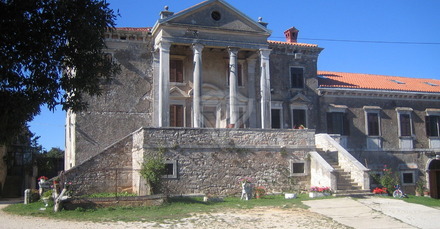to enlarge


or choose the place
from the menu below
 Rome |
 Byzantium |
 Venice |
 Vienna |
 Brioni |
 Smrikve |
 |
 |
Sv. Ivan is located on the old road that goes from Vodnjan to Vizinada. Few kilometres after the cross road for Porec that is located nearby Sv. Lovrec Pazenaticki you will find the indication for Sv. Ivan on your right side of the road. People that love architecture will recognize the style of the famous Renaissance architect Andrea Palladio in this building.





SV. IVAN – VIRTUAL TOUR AND HISTORICAL OVERVIEW
Sv. Ivan is the place where one of the most pretty Istrian countryside complex have been built by Polesini and Scampicchio family. Polesini family was an old Istrian Noble family that had important properties in Motovun and in Porec.
A part of this Polesini family villa in Sv. Ivan the other important and attractive Istrian countryside villas are: De Franceschi family villa in Seget, Rigo family villa in Karpinjan, Grisoni family villa in Dajla, Barbo family villa in Belaj, and Lazzarini Battiala Palace in Sv. Martin.
All these villas and palaces have developed following a smiliar concept. They have in the centre of the complex the main building and on the each side the lower husbandry or secondary buildings. Each mentioned villa is worth to be visited. For sure each of this countryside buildings witness the wealth and high culture of living of the upper social classes in Istria during the last centuries.
Few hundred meters after the Church of St. John the Baptist that was built in 1670 you will arrive near the gate of Villa Polesini. There is a long wall that surround the property and create a big garden.
_small.jpg) The first building you will notice inside the property is the representative neo-classical façade
with columns. The whole property was built in the 17th century.
The first building you will notice inside the property is the representative neo-classical façade
with columns. The whole property was built in the 17th century.
It is assumed that the project derives from the drawings of the famous architect Andrea Palladio.
The original stairs have been transferred in 1896 by Polesini family to another property this family owned on Sv. Nikola island in front of Porec.
Inside the court yard of the buildings there is a well and around the building to the right side of the main façade you will see an old harvester in the garden.
If you walk around the building you will note how huge it is and on the back side of it there is a door that connect the court yard, where the well is located, with the garden and the wood that is located on the back of the building.
Like most other Istrian villas mentioned in Istria from Smrikve, also villa Polesini would need significant investments to return to its original beauty.
Sv. Ivan is another old settlement and some rests found in 1624 from the Roman period proves that it was a Roman settlement. Around the area there were also prehistoric hill fort settlements.
Also this settlement, like most other Istrian settlements, had different names in its long history. It was St. Giovanni della Cisterna, St. Giovanni di Sterna, San Zuan di Sterna during the Venice domination.
In the donation document from 1102 when Marquis Urilch II donated many Istrian properties to the Aquileia Patriarchs was named Villa Cisterna.